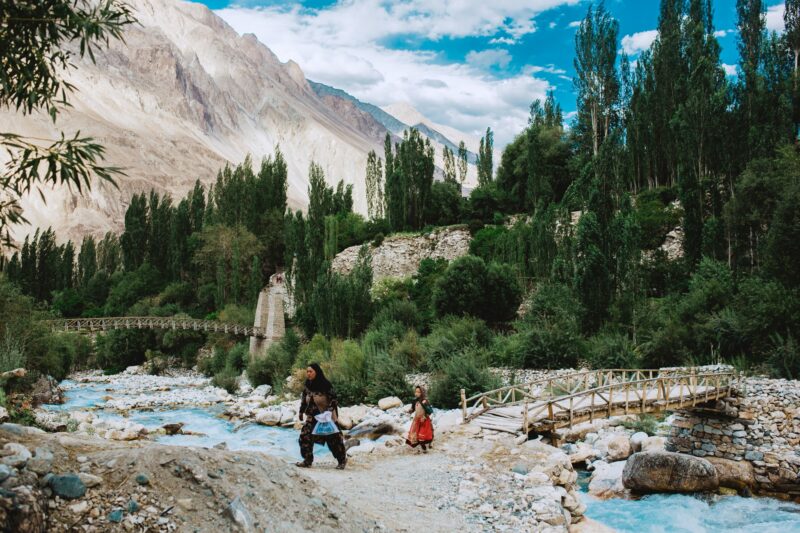
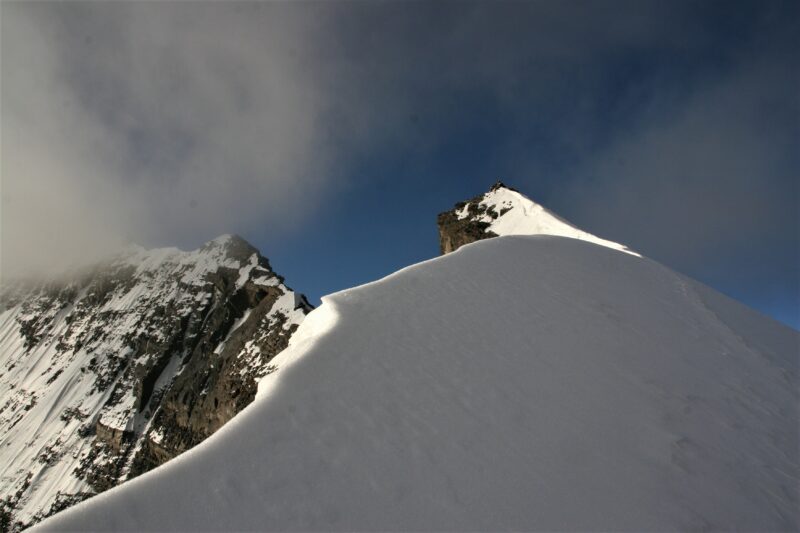
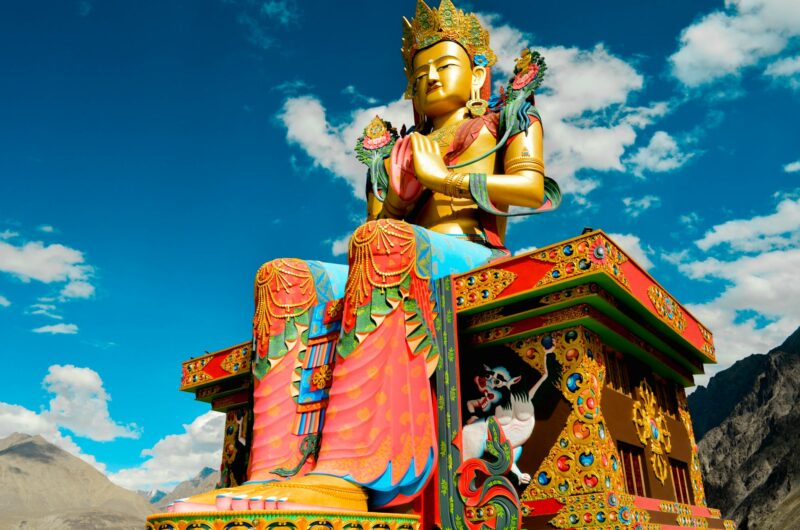
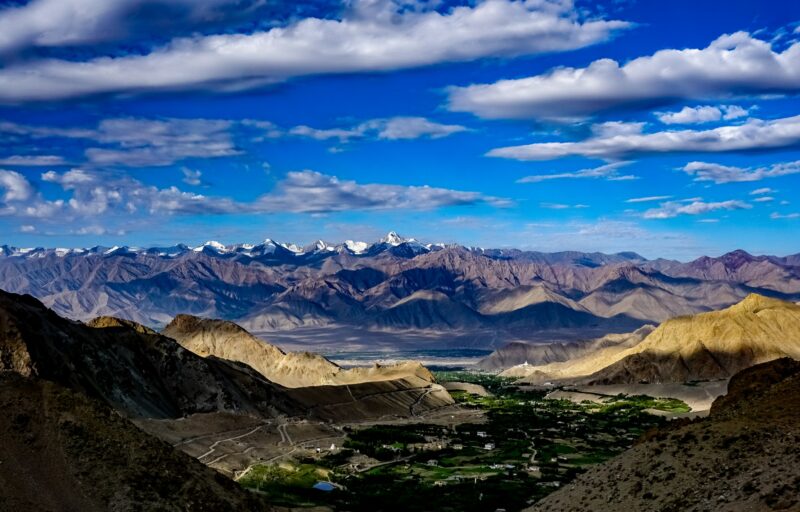

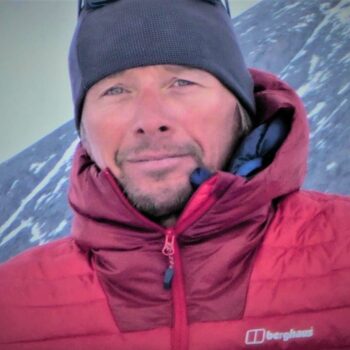
The perfect first Himalayan Summit in a mystical ancient land
Fly to Delhi and connect for our flight to Leh. It’s one of the most spectacular connection flights going, taking us right over the Himalaya to one of the highest airports in the world at 3,350m.
Once in the mountain town of Leh it’s time to let the jet lag do its thing for a bit. Feel free to take a wander around the Old Town or the bazaars and tandoor stalls as you acclimatise to the altitude.
It takes a few days to acclimatise to these altitudes when you’ve
We drive from Leh to Spituk and into the Zingchen Valley, where the convergence of the Rumbak and Indus rivers flow into a beautiful canyon. Our camping spot for the night is just outside Rumbak, a 15-family village built into the hill.
come straight by plane, so there’ll be a leisurely sightseeing tour of the town on offer should you wish to join. On the agenda will be a visit to Shey, a former Royal Palace of the Ladakh kings, featuring a 350-year-old copper and gold statue of Buddha; the small hamlet of Tikse and then onoto Stakna, a small monastery that sits above the Indus river.
A long ascent for our first day of climbing will take us up the Ganda La pass, marked by prayer flags and chortens. The Zanskar range and the distant peaks of the Himalaya will be a stunning backdrop to the day, and if we’re lucky, we might get a glimpse of some local marmots or blue sheep. A gradual descent will bring us to Shingo, a hamlet inhabited by only 2 families. This will be our campsite for the evening.
The start of today’s walk will be characterised by a spectacularly colourful and fascinating natural canyon. Eventually it opens into the green Skiu valley, where we’ll pass the ancient ruins of a castle, once a rest stop for the royal family on the journey to Srinagar. We’ll take their advice and stop for a snack before continuing on to Hamurtse, a sweeping green pasture by the Markha river.
The trail meanders alongside the Markha River, passing the remains of old hermitage caves high on the cliffs. There are fascinating remains of caves and platforms built into the cliffs where lamas would sit in meditation. Today’s trail is also marked by chortens filled with small piles of ‘Tsatsas’, the remains of ashes of the departed formed into tiny pyramids. We’ll stop at Markha for a rest, then visit the Techa monastery before reaching Umlung, where we’ll bed down for the night.
Continuing to zigzag across the Markha River, past old stone-mills, castle ruins and the village of Hankar, we will start to see the snowy peaks above Nimlang come into view. We cross Chaktsdang La and camp in Thachungste.
IIt’s not far from Thachungtse to Base Camp but the path is very steep and the effect of the altitude will be noticeable. 2 hours hiking will bring us to the Nimaling plateau, where the inhabitants of the Markha valley bring their animals to graze during the summer. From Nimaling, we’ll head slowly and steadily towards Base Camp.
A big breakfast sets us up for the day and we head out for an acclimatization walk. We’ll be back at Base Camp by noon for a hot meal and an afternoon of rest ahead of the summit attempt.
We’re up very early to reach the summit. Whilst the first part of the trail is rocky, we soon hit the snow level at around 5500m, so crampons and ice axes are necessary here. We pick our way through the snow as the sun starts to emerge and the lofty summit comes into view. All the hard work and the altitude sickness of the past few days is forgotten as the sense of achievement at climbing this mighty peak rushes over us. We’ll lay some prayer flags on the summit, take some photos and take in the unrivalled views before descending back down to base camp for a well-deserved rest
Our final day of trekking takes us from Base Camp to Kongmaru La, the highest pass on Markha Valley trek. We’ll savour yet more spectacular views before descending the steep, rocky path and coming out into the Shang Gorge, another naturally beautiful gorge. As we reach the village of Chogdo, it’s time to say goodbye to our horses and horsemen and begin the drive back to Leh.
An early start from Leh to catch the flight back to Delhi and then back to the UK. Depending on your flight there may be a chance to do a free city tour of Delhi.
Food served on this trek is vegetarian and consists of a wide variety of Tibetan, Indian and continental dishes.
Breakfast: Chapati, bread, jam, cheese, butter, cornflakes, omelette, porridge, pancake, tea, coffee
Lunch: bread, cheese, jam, fruit, spring rolls, chocolate, boiled potato and egg.
Dinner: Tibetan, Indian and continental dishes.
If you have food allergies, let us know in advance and we’ll do our best to cater for these.
Drinking water comes from a stream or spring near the campsite. As it’s mostly rain run off or snow melt it’s going to be pretty pure to start with but we’ll boil or treat anyway for good measure.
There are streams and springs on the way so bring purification tablets or a water filter (the latter are noticeably heavier and bulkier than the former) you can replenish whenever you run out, but generally we fill our bottles up in the morning before we set off.
We use 3 man tents for two people to give you a bit more personal space and more room for your gear.
Most altitude related symptoms manifest themselves at night. We therefore recommend room and tent sharing from the onset of all our expeditions. Room share is always organised according to sex and where possible age groups. Obviously if you are climbing this mountain with a friend or partner then share rooms with them. If you have joined the team by yourself then it is highly likely that you will be sharing a room with your pre-assigned room buddy unless prior arrangements have been made.
If you would like your own hotel room, please contact the office to make arrangements, a modest single supplement fee will be requested.
Yes, we provide dining tents for meals and to relax and wind down in after a day’s walking.
There are no fixed camps in the mountains, so we carry all camping gear with us on horses, pitching camp near some of the reliable water sources. In terms of the camp “facilities”, there is a portaloo toilet in its own tent, and a shower tent.
There are different types of altitude sickness. Although our acclimatisation regime ensures that everybody enjoys the best possible chance of getting high on the mountain, altitude-related problems can happen. The most common of this is high altitude sickness, (AMS – Acute Mountain Sickness).
Symptoms for this generally include:
Headaches
Nausea
Vomiting
It all sounds quite dramatic but generally this is just the process your body naturally goes through to adjust to the higher altitudes and the reduced partial pressure of the atmosphere.
For some people the acclimatisation process is a little longer and harder than others. For our guides this is all part and parcel of trekking at relatively high altitude and ascending a 6,000m peak and although we asses each client’s personal situation carefully we also further consider the compounding affects of dehydration brought on by excessive vomiting and lack of appetite.
In most cases AMS can be avoided by following guidelines:
Drink lots of water
Walk slowly
Stay warm
Eat well
We recommend that you familiarise yourself with the various affects that altitude can cause. During your pre-climb briefing, we describe altitude sickness to you in detail, and advise you how to cope with it. The most important thing is not to fear it, but to respect it and to know how to deal with it and more importantly tell your guides how you feel.
Our guides have seen every condition that can occur on this trek, and they will always know how to deal with problems.
HACE and HAPE rarely occur on this trek and our guides are fully trained in recognition of the onset of these problems and will deal with them at the first sign of their development.
We’re in the developing world now, and help isn’t quite so easily at hand. However, if there’s a serious injury or sickness the leader carries a satellite phone and we can get a helicopter from the Indian Air Force to airlift a casualty to Leh. Remember you’ll need insurance to cover the expenses if this happens.
If you are unlucky and you become sick and are not able to complete the climb then we take you to the nearest road head, which will be Skiu which can take a few days to reach and drive back to Leh. In very severe cases we can also arrange helicopter. This cost will be covered by yourselves and thereafter your insurance company
Please do note that it is rare that people get any altitude sickness after being in the mountains for so long and crossing the other passes, but if you do we have an evacuation plan in place as mentioned.
There is no malaria or yellow fever in Ladakh, and you don’t need a yellow fever certificate UNLESS you are traveling from an area where YF is present.
The standard vaccinations that are generally recommended for travel to the Indian subcontinent are Hepatitis A, Typhoid, Diphtheria, Tetanus and Polio, some people consider a rabies jab to be important. However you should consult your doctor, travel clinic or nurse practitioner for the most recent accepted advice rather than take our word for it.
Yes, all our trips are for people of 18 years of age and older.
September is the best time for climbing Kang Yatse 2, offering stable weather and good temperatures.
Whilst there can sometimes be rain/snow showers, it is usually very stable.
September also has the added advantage of fewer trekkers.
Summit night, like that of Stok Kangri is punchy. We will start between midnight and 1 am and hope to be on the summit 8-10 hours later. There will be approx.. 1200m of gain on this night and you are to expect a 16 hours day.
Kang Yatse is split into two peaks. You have the higher more technical peak Kang Yatse at 6496m. This peak involves a difficult knife-edge traverse.
The lower western peak, Kang Yatse 2 (the one we will be climbing) has been recoded being the height of anything between 6195m and 6350m. No concrete height has been recoded.. so for now we will use the height of 6250m which seems to be the most common documented.
On the trekking phase we have one overall leader who runs the expedition, assisted by 1 local guide per 8 clients. Once we reach base camp the team increases and we use 1 local guide per 4 clients.
On a day to day level remember that you will be camping at altitude in cold temperatures. You are likely to be cold, washing and toilet facilities will be limited, your appetite may be affected by the altitude and as you get higher on the trek you are likely to suffer shortness of breath and many people experience difficulty sleeping. Remember that everyone on the trek is likely to be experiencing exactly the same symptoms, physical and mental.
Climbers are expected to be in good physical condition. The better your physical shape the more you will be able to handle the demands of trekking to the base camp and then climbing the peak. Having a good level of fitness will allow you to enjoy the expedition all the better and increase your chances of reaching the summit.
Yes.. as it is the north -west face there is always snow ! Due to this we will be providing you with crampons, ice axe and a harness for this summit push. Your boots must be good sturdy trekking boost B11 (3 season) with a semi – ridged sole. Once we reach the snow line we will be roped up.
The temperature in the mountains can vary from 30C during the day to 0C n the evenings. Add some windchill on summit day and it could be somewhat cooler. In Leh the temperature can vary between 15 – 35C.
Your guide will generally meet you at the airport. At the check-in desk look for someone who looks like they climb mountains for a living
You must carry individual travel insurance to take part in the trek. We cannot take you on the mountain without proof of insurance.
It is your responsibility to ensure that you have the appropriate insurance for your intended trip. To include medical evacuation and coverage up to the maximum altitude of this trip.
Your insurance details are requested on the booking form, however this can be arranged at a later date. We will be requesting your insurance details 8 weeks before your departure.
The training programs have been devised to be expedition specific. Use these as a guide but also feel free to contact us for individual advice on how to best incorporate the most suitable fitness program with your own lifestyle. The idea is to increase the intensity of the exercise over 4 to 6 months before you leave for the expedition. Concentrate on cardiovascular work-outs during the initial weeks by taking short runs when time allows and try to spend at least 2 weekends a month going on long duration walks (longer than 6 hrs) carrying a rucksack of around 10kg. As you get stronger increase this rate of exercise and the duration by walking every weekend and running 5km every second day.
A focused regime will not only prepare your body for carrying minor loads but will harden your body against the big days on the mountain itself. In addition the weekend walks will help break in your boots and get you used to your equipment. In combination this will pay dividends when you reach Kang Yatse 2 because even though you can’t train for altitude your body will be ready for arduous days and you will be familiar with how to best use your equipment.
Generally speaking deposits are due upon booking as we need to book your international flights well in advance. The full amount should be paid 4 months prior to departure. However having said this, our aim is to get you to the top of this mountain and we understand that personal financial situations can vary. Please contact our friendly office crew to discuss a suitable payment plan if monthly payments would make life easier.
Please read our terms and conditions carefully before you depart. We highly recommend trip cancellation insurance for all expeditions. Due to the nature and heavy costs of government and operator permits we must adhere to a stringent refund policy.
You can’t buy or sell Indian Rupees outside of India. Therefore we would recommend taking either British pounds or American dollars and then changing them when you arrive in country. Both are readily recognised and are easily converted to the local currency. Upon arrival there will always be a bureau de change at the airport. There are also plenty of ATM’s around Leh. Generally either of these provide a better rate of exchange then your hotel.
Again, do check with your bank, what the charges are for withdrawing cash in India.
The amount of money you will need depends on how many presents you wish to buy or how much you wish to drink when you come off the hill. As a basic rule of thumb $300 should be more than adequate for any post expedition spending. India is a relatively cheap place and when indulging in the local custom of haggling then goods can be very good value for money. The only cash you’ll need to consider taking with you on the mountain is the local crew tips which are presented to them usually on the final evening at the last camp before you sign out from the national park.
Our local crew work extremely hard to ensure that your expedition runs well. While tipping is not compulsory, once you see how hard the crew work and realise the small amount of money they get paid relative to one’s own income, tipping will seem the least you can do to say thank you. As a general rule we suggest between $80-100 for tipping the local crew.
For the leader this is your call.
Opportunities to charge your batteries will be limited. If you can get hold of a solar battery charger this is probably the best option. This together with making sure that you keep your spare batteries warm i.e. by keeping them near your body day and night should mean that you can keep snapping all the way!
Your best bet is to buy a local SIM to use in and around Leh to call out as it’s very unlikely that the local networks will you let you join through your UK operator.
While we will do everything we can to provide adequate safety for the group and security for your possessions, the general rule is that if you don’t need it, don’t bring it. This includes jewellery, necklaces, rings and even watches. Your passport and money should be kept on you at all times. As with travel in any foreign country, you need to look after yourself and your possessions, and this is no different.
